Bulletin of the United States Fish Commission 1897
The Salmon Fishery of Penobscot Bay and River 1895-1896
By Hugh M. Smith.
CONTENTS
Total number salmon caught in tidal Penobscot River & Bay,1895-96
Comparative data relative to the salmon fishery
Apparatus & methods of the fishery
Salmon at Matinicus & Ragged islands
Salmon at the Cranberry Isles
Salmon caught with hook off Maine coast.
Destruction of Salmon by Seals
Evidences of results of propagation.
Extension of salmon-hatching operations on the Penobscot.
Planting of quinnat salmon & steelhead trout in Maine streams
During the months of August and September, 1896, the writer visited the shores of Penobscot River and Bay in the interests of the United States Fish Commission, for the purpose of securing data regarding the condition and extent of the salmon, shad, and alewife fisheries. Special attention was given to the salmon fishery, as the Penobscot is now the only important salmon stream on the Atlantic coast of the United States and has been the field for very extensive fish-cultural operations on the part of the Fish Commission. A large majority of the owners of the salmon weirs and nets along both sides of the bay and river were interviewed and accurate accounts of their fishing obtained, together with their observations as to the effect of artificial propagation on the supply.
The history and methods of the salmon fishery of this basin have been well presented in papers by Mr. Charles G. Atkins, superintendent of the Government hatchery at Craig Brook, Maine.*(1,2) The present paper is primarily intended to show the extent and condition of the salmon fishery of Penobscot Bay and River in 1895 and 1896 and the influence of artificial propagation on the supply. The methods and apparatus of the fishery are briefly considered. A chart of the Penobscot region, giving the location of salmon weirs and traps in use in 1896, is appended, and illustrations of some of the types of salmon apparatus are shown.
Extent and condition of the fishery in 1895 and 1896. While the number of nets operated in these two years was practically the same, the catch in 1896 was much greater than in 1895, and was one of the largest in the recent history of the fishery. A comparatively large number of fishermen reported that they took more salmon than in any previous year. The salmon, however, were smaller than usual, and their market value was but little more in 1896 than in 1895.
The traps set especially for salmon, or in which salmon were taken, numbered 193 in 1895 and 184 in 1896. These, with the accessories, had a value of $12,474 and $13,146, respectively. The boats and scows required in the construction and operation of the nets numbered 188 in 1895, the same in 1896 and were valued at $3,576 and $3,599, respectively. The number of men engaged in the fishery was 127 in 1895 and 126 in 1896. In the comparatively unimportant branch of the fishery carried on with gill nets in the vicinity of Bangor, 10 nets, valued at $189, were used in 1895, and 11 nets, worth $199, in 1896; these were set by 6 men in the first year and 7 in the next. The boats numbered 4 in 1895 and 5 in 1896, and were valued at $39 and $37, respectively.
* (1) On the Salmon of Eastern North America, and its artificial culture. In Report of Commissioner
of Fish and Fisheries 1872-73, pp. 226-337, 9 plates of apparatus and methods, and map
s show location of salmon weirs in Penobscot Region.
(2) The River Fisheries of Maine. In "The Fisheries and Fishery Industries of the United States",
section v, vol. 1, pp. 673-728.
Total number salmon caught in tidal Penobscot River and Penobscot Bay.
The total number of salmon caught in 1895 was 4,395; these weighed 65,011
pounds and yielded the fishermen $11,356; in gill nets 117 salmon were caught,
weighing 1,985 pounds and valued at $323. In 1896 the result of the fishery was 6,403
salmon, weighing 80,175 pounds, with a market value of $12,716; the gill-net catch
this year was 246 salmon, with a weight of 3,444 pounds and a value of $492.
The outcome of the fishery in 1896 exceeded that of 1895 by 2,008 salmon; increase in weight was 15,164 pounds, and in value $1,360. The percentage of increase in these items was as follows: Fish taken, 46 per cent; weight of catch, 23 per cent; value of catch, 12 per cent.
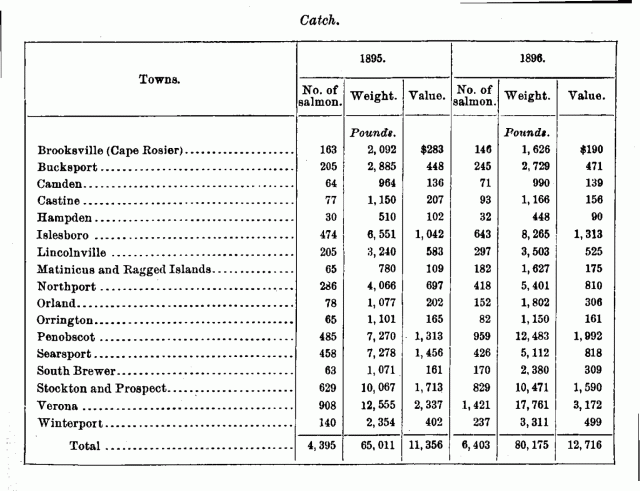
As an illustration of the uniform increase in the number of salmon taken in 1896, the following facts may be cited: The nets that were set in both years numbered 162; of these, 146 nets, or 90 per cent, took more salmon in 1896 than in 1895; and only 16, or 10 per cent, took the same number or less. The comparative figures for the nets that secured more fish in 1896 were 3,449 salmon in 1895 and 5,681 in 1896. The nets whose catch was the same or less in 1896 caught 295 fish in 1895 and 289 in 1896.
The largest number of salmon taken by one fisherman in 1895 was 408; these were caught in 3 nets on the lower side of Sears Island, in the township of Searsport. Other catches by single fishermen in 1895 were 104 salmon in 4 nets in Stockton, 102 in 5 nets in Northport, 150 in 3 nets in Islesboro, and 150 in 3 nets in Verona.
In 1896 the 3 Searsport nets first mentioned took 426 salmon, and a large number of fishermen secured between 100 and 200 fish in 2 to 5 nets. Thus, in Stockton 100 fish were caught in 2 nets, 105 in 3 nets, and 110 in 1 net; in Penobscot 192 salmon were taken in 2 nets, 105 in 2 nets, and 127 in 2 nets; in Northport 5 nets obtained 204 fish and 4 nets 125 fish; in Islesboro 3 nets took 130 fish, 3 nets 150 fish, 4 nets 190 fish, and 2 nets 100 fish; in Verona 3 nets caught 174 fish, 2 nets 106 fish, 3-nets 150 fish, 1 net 100 fish, and 2 nets 170 fish.
About 80 per cent of the fishing is done in that part of the river between the northern end of Whitmore Island and Islesboro. While single weirs in that part of the river between Bucksport and Bangor may take as many as 50 or 60 salmon some seasons, the average was only 14 in 1895 and 26 in 1896, and the aggregate is comparatively small. In the townships of Lincolnville and Camden, which are the lowest points in the Penobscot region at which salmon fishing is done, the average catch to a net in 1895 was only 16 salmon and in 1896 only 19 salmon.
Detailed statistics for 1895 and 1896. The following tables show, by townships, the extent of the salmon fishery of Penobscot Bay and River in 1895 and 1896:
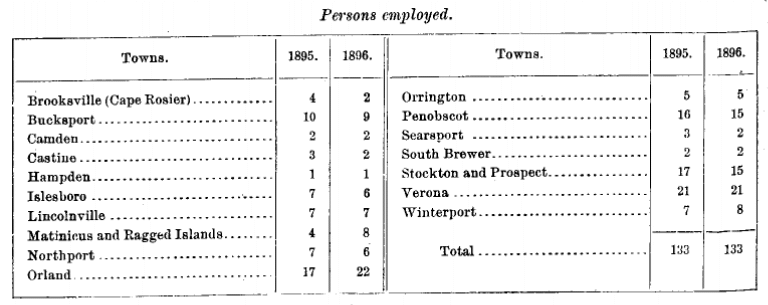
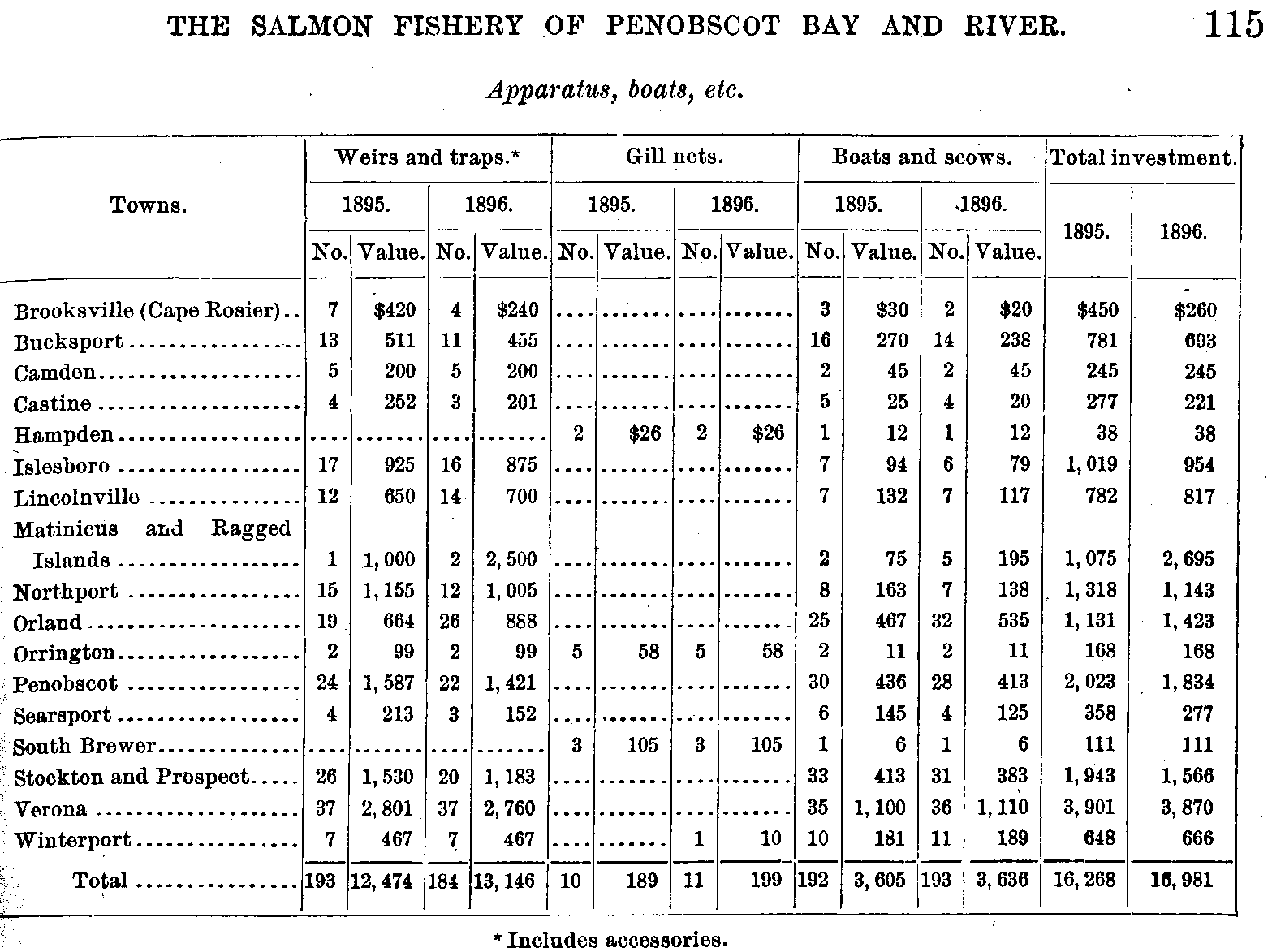
Comparative data relative to the salmon fishery. In 1880 the catch of salmon in Penobscot Bay and River and their tributaries was 10,016, having an estimated weight of 110,176 pounds. The weirs and traps used numbered 230; the gill nets, 36. The fishery yielded 169,894 pounds, valued at $32,800, in 1887; 192,177 pounds, worth $38,049, in 1888; 140,469 pounds, valued at $31,156, in 1889, and 92,282 pounds, worth $19,124, in 1892.
As previously shown, in 1895 193 traps and 10 gill nets took 4,395 salmon; weighing 65,011 pounds, valued at $11,356, and in 1896, 184 traps and 11 gill nets caught 6,403 salmon, weighing 80,175 pounds, valued at $12,716.
Comparing 1896 with 1880, it appears that there was a reduction of 27 per cent in the number of nets used and a decrease of 36 per cent in the number of salmon caught. A relatively large catch was made in 1887 to 1889, inclusive, and the decrease in 1896, as compared with those years, was marked. From 1892 to 1895 the output declined nearly 30 per cent, and the general tendency for the past eight years has been toward a decrease, 1896 presenting a very pleasing contrast, of which the fishermen all make mention.
Following is a continuous record from 1874 to 1896 of two of the most successful salmon weirs. These are located on the east side of the river, in the town of Penobscot, a short distance from the southern end of Whitmore Island. The number of salmon taken in 1896 was 20 per cent greater than in any previous year and over 93 per cent greater than the average for the preceding 22 years. Similar comparative statements for other nets are at hand, showing the increase in 1896 over previous seasons. < P>TABLE Record of two Penobscot River salmon weirs, from 1874 to 1896, inclusive.
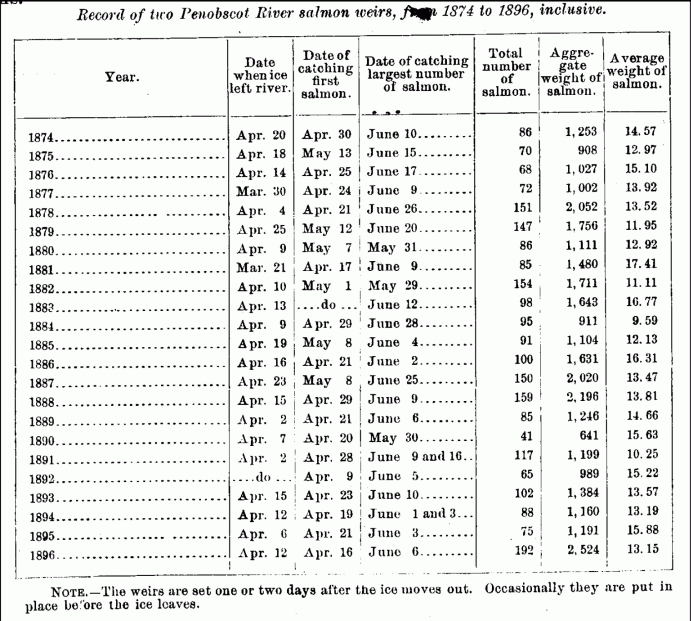
Caption: Record of two Penobscot River Salmon weirs, from 1874 to 1896, inclusive.
NOTE at bottom of chart:
The weirs are set one or two days after the ice moves out. Occasionally they are put in place before the ice leaves.
Apparatus and methods of the fishery. There is probably no other river in the United States in which a fishery of such magnitude has undergone so few changes with respect to methods, number of traps operated, and sites where nets are set, as the Penobscot. This is chiefly owing (1) to the character of the bottom, (2) to the fact that the fishing is a riparian privilege enjoyed only by those who own land fronting on the water, (3) to the circumstance that the fishing is almost entirely of a semi-professional character, and has been taken up by generation after generation as a part of the regular duties connected with the small farms, and (4) to the small number of food-fishes occurring in the river, and the preponderating importance of two of them--the salmon and the alewife--for which the nets are exclusively set.
SALMON NET TYPES
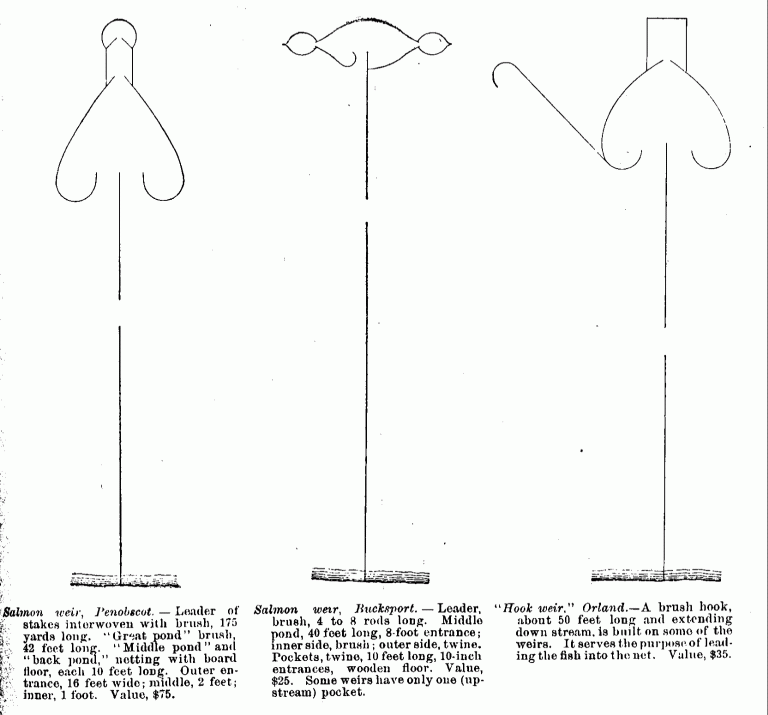
The salmon fishery of the Penobscot basin is carried on with practically a single type of apparatus, namely, the brush weir. In most parts of the region this trap is used in the same form that it had in the primitive days of the fishery, but in some sections the weir has undergone evolution into a combination brush and twine trap, and in places into a trap made wholly of netting.
Some of the types of salmon nets used in this region are illustrated and described by the accompanying figures. In addition to these, which are wholly or partly of brush, a common apparatus is the floating trap, constructed entirely of twine, such as is now generally employed in the New England States. This is the only salmon net in use at Islesboro and in some other sections. The local and individual variations in the form of the nets depend on the topography of the bottom and shore and the habits of the salmon, and are the result of long experience.
The fishing begins as soon as the ice moves out in spring and continues until some time in July. Fish are rarely taken before the last two weeks in April. May and June are the best months. In that part of the river adjacent to Bangor there is a small fishery prosecuted with set gill nets. The nets are from 100 to 200 feet long and have a 6-inch mesh.
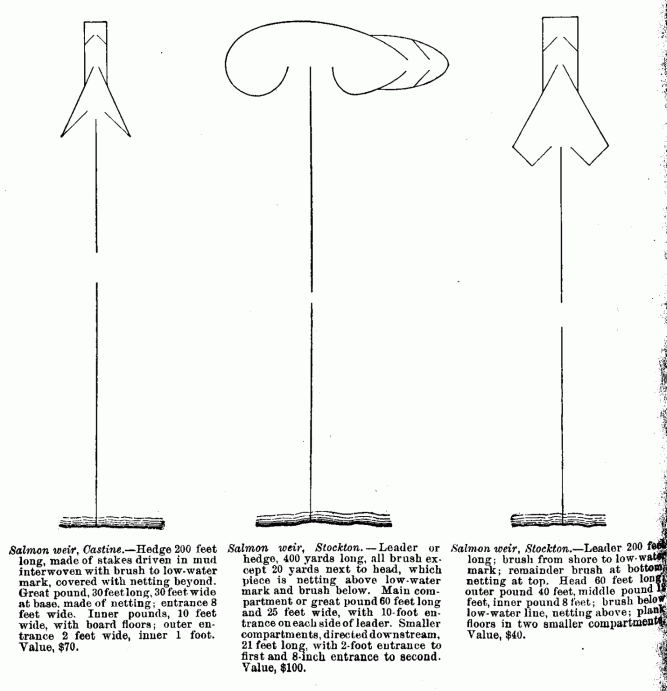
Salmon weirs, Winterport, Orland, Verona
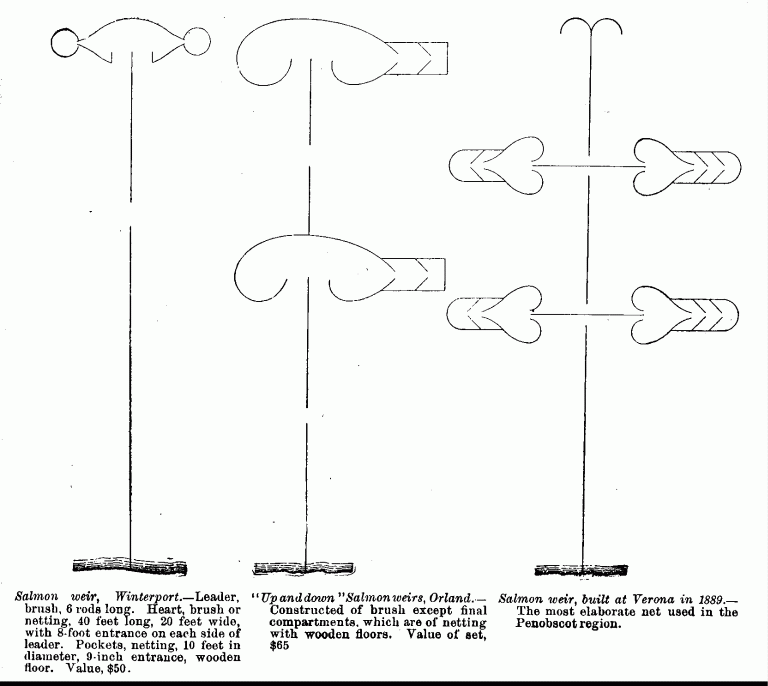
Salmon weirs, Winterport, Orland, Verona brush, 6 rods long. Heart, brush or netting, 40 feet long, 20 feet wide, with 8-foot entrance on each side of leader. Pockets, netting, 10 feet in diameter, 9-inch entrance, wooden floor. Value, $50.
Center caption
"Upanddown" Salmon weirs, Orland.
Constructed of brush except final
compartments, which are of netting
with wooden floors. Value of set, $65
Right caption
Salmon weir, built at Verona in 1889.
The most elaborate net used in the
Penobscot region.
Salmon at Matinicus and Ragged islands. Matinicus is a small island located south of Penobscot Bay and about 15 miles southeast of the nearest mainland (Thomaston). It is in the route of salmon coming in from the sea to ascend the river, and nets set in favorable positions would naturally be expected to intercept the fish. On the western side of the island Messrs. R. Crie & Sons have operated a trap for mackerel and herring for four years, and during that time have incidentally taken a number of salmon. Between May 20 and July 10 marketable fish are caught, while in August and September salmon too small to utilize are taken in considerable quantities; in the opinion of the Messrs. Crie these small fish were on their way to sea from the Penobscot River.
It has been observed that when an easterly wind is blowing very few salmon are taken, but during a westerly wind salmon are always obtained in the months named, and the quantity of salmon secured in any given year bears a close relation to the direction of the prevailing winds. In 1895 the number of marketable salmon caught was 65; in 1896 the catch was 167. The largest fish taken in the two years weighed 30 pounds, the smallest 1/2 pound. The largest daily catch was 31 salmon, in 1896; the next largest, 27, in 1894.
Mr. W. B. Young, of Matinicus Island, has a herring weir on the southwestern part of Ragged Island, which lies a short distance south of Matinicus Island. In 1896 this weir during June and July caught 15 salmon with an aggregate weight of 200 pounds. The largest weighed 24j pounds. No small, unmarketable ones were obtained.
Salmon at the Cranberry Isles. The Cranberry Isles lie a few miles south of Mount Desert Island and about 25 miles east of Penobscot Bay. They are in the track of migrating salmon, as a few herring weirs set around the islands have for several years taken one or more salmon almost annually.* Mr. W. I. Mayo, a correspondent at the islands, reports that in June, 1895, Colonel Hadlock took a 17-pound salmon in a weir, and on May 5 of the same year Mr. Mayo caught one weighing 19 pounds. None had been taken, however, in 1896 up to September 1.
(Footnote* See paper entitled "Notes on the capture of Atlantic salmon at sea and in the coast waters of the Eastern States," Bull. U.S.F.C. 1894.)
Salmon caught with hook off Maine coast. Instances are multiplying of the taking of salmon at sea on trawl lines on the New England coast. The salmon are usually taken during the time when the fish are running in the rivers, but occasionally one has been caught in midwinter. The following data relate to fish that probably belonged to the Penobscot school.
On June 19, 1896 a Gloucester fishing vessel brought into Rockland a 10-pound salmon that had been caught on a cod trawl 20 miles southeast of Matinicus. The fish was sent home to Gloucester by the captain of the vessel, through Mr. Charles E. Weeks, a Rockland fish-dealer.
Several salmon have been taken on hooks off Frenchman Bay within a few years. One 25-pound fish was caught on a cod trawl 3 miles off Gouldsboro, in 20 fathoms of water, and another was taken southeast of Mount Desert Island in 35 fathoms.
Some years ago, on May 22, one of the crew of the schooner Telephone, of Orland, Me., while fishing for cod on German Bank, caught a 10-pound salmon. German Bank lies about 50 miles southeast of Mount Desert Island and has 65 to 100 fathoms of water.
Destruction of salmon by seals. Seals are known to kill a great many salmon in Penobscot Bay and the lower river. They enter and leave the weirs and traps with out difficulty and cause great annoyance to the fishermen. When a seal enters a net, the fish are frightened and usually become meshed; the seal may then devour them at its leisure. The initial bite usually includes the salmon's head.
Fishermen in some places report a noticeable increase in seals in the past few years, and a consequent increase in damage done to the salmon fishery. The State pays a bounty of $1 each for seal scalps, which serves to keep the seals somewhat in check, although the sagacity of the animals makes it difficult to approach them with a rifle and to secure them when shot. Within a few years some weir fishermen have been obliged at times to patrol the waters in the vicinity of their nets, in order to prevent depredations. In the Cape Rosier region, where some salmon trap fishing is done, seals were very troublesome in the early part of the season of 1896. Mr. George Ames, who set three traps in 1856 and took about 100 salmon, had knowledge of 13 other salmon that were destroyed by seals while in his nets. Similar instances of relatively large numbers of salmon killed by seals might be given. With salmon worth 20 to 50 cents a pound the loss of 10 or 12 salmon by seals, in a total catch of 75 or 100, is a matter of importance to the fisherman.
Evidences of results of propagation. The opinion is now practically unanimous among the salmon fishermen of Penobscot River and Bay that the artificial hatching of salmon by the U.S. Fish Commission is producing beneficial results. About the same arguments in support of their opinions are presented by all, and these accord well in the main with the observations of other persons who have given this matter attention:
(1) The opportunities for natural reproduction are exceedingly limited, owing to the obstructions to the passage of the fish to their spawning grounds in the headwaters of the Penobscot basin.
(2) The salmon that are naturally hatched are, even under the most favorable conditions prevailing at the present time, not numerous enough to keep up the supply of market and brood fish, with the fatalities incident to the long residence at sea and to the passage of immature fish down from the spawning grounds to the sea.
(3) The remarkable run in May and June, 1896, of fish of comparatively small size that had apparently just reached maturity and the relative scarcity of large fish that had evidently been in the river during one or two previous seasons seemed to show a tendency toward the depletion of the run of old fish and the substitution of a run of young, artificially hatched fish.
(4) A feature of the salmon supply in recent years, on which the fishermen nearly all lay considerable stress, is that the runs in April and July, which in former years were often quite important and remunerative, have of late been very poor, although the fish constituting them are of large size, while the runs in May and June have kept up, but have consisted chiefly of comparatively small fish. In this the fishermen believe they see evidence of the work of the hatchery, for the young salmon artificially hatched have been from eggs of May and June fish, and the fishermen think that such young fish, when they return to the river to spawn, will come at about the same time that their parents did.
Many salmon fishermen might be quoted on the question of results of propagation. A few sample statements and records of salmon taken will be given covering different parts of the bay and river.
Mr. Francis French, an experienced salmon fisherman of Stockton, on the western side of Penobscot Bay, reports that of the 61 salmon taken in his weir in 1896, 56 were under 11 pounds in weight, and all evidently belonged to the same year's brood. In 1895 the 29 salmon obtained by Mr. French averaged 20 pounds each. According to his observations, a very large percentage of the salmon in the Penobscot region in 1896 were hatchery fish that then entered the river for the first time.
Mr. A. H. Whitmore, a salmon fisherman of over thirty years' experience, who fishes three weirs off the southern end of Whitmore Island, states that in that part of the river the catch in 1896 was the largest in thirty years, with the exception of one season. He thinks there is no doubt whatever of the beneficial results of artificial propagation, as shown by the maintenance of the supply when obstructions to the passage of salmon to the upper waters must greatly curtail natural spawning.
Mr: Joseph Hurd, of Winterport, has two weirs at Oak Point, which is the upper limit of weir fishing for salmon on the west side of the river; the nets are about 12 miles below Bangor; 25 salmon were taken in 1895, and 60 in the following year. The catch was better in 1896 than in a number of years. Eight years before, Mr. Hurd took 140 salmon, which was the best season in his experience; since then the fish have been decreasing until 1896. He thinks very few fish get to their spawning-grounds, owing to dams and other obstructions in the river above Bangor, and has no doubt the small fish which were so conspicuous in 1896 were from the Government hatchery.
Mr. William F. Abbott, of Verona, who has two weirs on Whitmore Island, caught 41 salmon in 1895, and 80 in 1896. He makes the following statement:
"In my opinion, there would not enough salmon come into the river to pay for building weirs if there had been no salmon artificially hatched; and I hope the Government will continue to keep the salmon fishing up, so it will pay to build our weirs. No person that knows anything about it can doubt that it is a good thing for the fishermen."
Mr. Harvey Heath, of Verona, has two weirs on the eastern side of the southern end of Whitmore Island. He caught 62 salmon in 1895, and 100 in 1896. He thinks that the removal of obstructions to the passage of fish to their spawning-grounds would be all that is necessary to secure a good run of fish in the river, but believes that under present conditions the salmon-cultural work of the Government is very useful in sustaining the fishery.
Three weirs of Mr. E. A. Bowden, located on the eastern side of Whitmore Island, above those of Mr. Heath, took, 31 salmon in 1895, and 85 in 1896. Mr. Bowden says:
"I think that if it was not for the hatchery we would not have any salmon to speak of, for all the school we have is in June. April, May, and July salmon are very scarce."
Mr. Charles G. Atkins, superintendent of the government salmon hatchery in Orland, Me., informs the writer that he has been inclined to believe that each year a great many salmon succeed in reaching their spawning grounds; but recent observations have caused him to change his mind, and he is now of the opinion that only relatively few salmon elude the traps, weirs, and gill nets, surmount the dams and fishways, escape the poachers, and succeed in depositing their eggs under conditions favorable to their development. The dam at Bangor, while certainly a formidable obstruction to the passage of fish, is probably passable at high water. It is provided with a fishway, and some fish are known to surmount the dam by this means. Above Bangor, in the main river, there are dams at Great Works and Montague, the dam at Montague being an especially serious obstruction, although it is provided with a good fishway. Below the dam at Bangor there is little poaching, but below the other dams--especially at Montague--comparatively large numbers of salmon are sacrificed by the illegal use of the spear and drift net. In 1896 all the salmon below Montague were at the mercy of poachers after July 15, when all wardens on the river were laid off.
The supply of spawning fish was thus greatly reduced. The people above Bangor have no interest in preserving the salmon supply of the river, as they receive none of the benefits from fishing which are enjoyed by fishermen of the lower river.
This year Mr. Atkins, having this matter under consideration, visited the east branch of the Penobscot River. A certain tributary of the east branch, which was said to be one of the best spawning-grounds for salmon in the Penobscot basin, was obstructed by a dam in the spawning region. The dam was impassable to fish in July, and had been so during the previous months. In a deep pool below the dam, which was reported to be a favorite resort for salmon each season, no salmon were found. In other words, if the salmon had reached this stream they could not have gotten above the dam, and would undoubtedly have congregated in the pool mentioned and been noticed, but no fish had ascended even that far.
Extension of salmon-hatching operations on the Penobscot. The establishment of branch hatcheries has been suggested in order to utilize the spawning salmon in the region which lies above commercial fishing, and thus increase by artificial means the production of young fish. It is well known that even under the best conditions, now prevailing in our streams the eggs of anadromous fishes like the salmon and shad are liable to numerous destructive agencies; that only a small percentage of the eggs laid under natural surroundings ever hatch, and that the young are subject to heavy mortality up to the time when they leave the river and enter the salt water.
Probably 5 per cent would be much too large an estimate of the number of salmon eggs which in a state of nature produce fish that reach the ocean. Fish-culture, on the other hand, hatches 95 per cent of the eggs and raises 75 per cent of the fry to the age of yearlings. Of 206,350 Atlantic salmon eggs obtained in 1895 at the government station at Craig Brook, 206,109 were hatched and 151,761 yearling fish were liberated in the fall. The percentage of eggs hatched was thus 99.88 and the percentage of yearlings raised was 78.39. This is sufficient ground for interfering with the salmon even after they have reached their spawning-beds, and justifies the establishment of hatcheries in the headwaters of the Penobscot, provided the supply of fish in any section is large enough to insure a reasonable take of eggs.
No examinations of the upper tributaries of the Penobscot thus far made have disclosed the existence of any stream on which the construction of a branch salmon hatchery is warranted, owing to the few salmon obtainable. The matter deserves further investigation, however, and will receive due consideration at an early date. It is thought that a satisfactory supply of fish may be secured by constructing a dam or rack which will intercept fish in the main stream and lead practically the entire run into one tributary, where they may be retained.
The operation of a branch salmon hatchery in the river above Bangor would of course depend on the successful working of the fishways and the enforcement by the State of the anti-poaching laws.
Planting of quinnat salmon and steelhead trout in Maine streams. The United States Fish Commission is making the experiment of planting large numbers of non-indigenous salmon in the Penobscot Basin and other Maine waters with a view to test whether the fishes are adapted to those streams. The species with which trials have thus far been made are the quinnat or chinook salmon (Oncorhynchus tschawytscha) and the steelhead trout (Salmo gairdneri). It is intended to plant sufficiently large numbers of yearling fish to fully test the feasibility of the project; and in the event of success two extremely valuable species will have been added to the fishery resources of the Maine streams."
During the years 1896 and 1897 over 2,000,000 young quinnat salmon and steelheads were deposited by the Commission in the Penobscot River and adjacent waters, several hundred thousand of which were four to six months old. The planting of additional fry and yearlings is contemplated in order to thoroughly demonstrate whether their introduction is possible.
The quinnat salmon ranges along practically the entire Pacific Coast of North America north of Mexico, entering all suitable streams. It is the most valuable member of the salmon family, and is taken in very large quantities for canning, salting, and fresh consumption. Its flesh is very rich and of a deep-red color. It is caught in the rivers with gill nets, seines, pound nets, traps, weirs, wheels, and other appliances.
Page 124
In Monterey Bay, California, large numbers are taken with trolling hooks baited with small fish, and, although the fish abstains from food after entering the fresh waters, it may often be lured with artificial or other baits. The chinook salmon begins to enter the California rivers in February, the Columbia in March, and the Alaskan rivers in May and June. The spawning season covers six months, extending from June to December, although the spawning period in any given basin is more limited, seldom exceeding one or two months. The highest accessible positions in the streams are sought by the spawning fish, which make rounded excavations in gravelly bottoms, in which the eggs are deposited. The vitality of the fish rapidly decreases after spawning, their bodies become mutilated and diseased, and in a short time they die.
The steelhead (Salmo gairdneri) also known by the names of salmon trout, winter salmon, and Gairdner's trout, closely resembles the Atlantic salmon in size, form, and habits. It is found from southern California to Alaska, and enters the coast rivers in large numbers. Its flesh is light-colored, but is of excellent flavor, being not inferior to the eastern salmon. It is caught in large quantities with gill nets and traps, for canning and use in a fresh condition. As a game fish the steelhead enjoys a high reputation in the Pacific States. Its principal run in the rivers is during the fall and winter months, when it ascends the streams long distances, spawning in late winter or early spring.
In order that anglers, fishermen, fish-dealers, and others may be able to distinguish from the Atlantic salmon and from each other any specimens of quinnat salmon and steelhead that come to their notice, the following key* has been prepared to cover the principal differential characters, and illustrations of the three species are shown:
I. Anal fin elongate, with 16 rays; gillrakers 9 + 14; branchiostegals 15 to 19; pyloric coeca 140 to 180; caudal fin considerably forked; average weight about 20 pounds, maximum 100 pounds...............Quinnat salmon.
II. Anal fin short, with 9 to 12 rays; gillrakers 8 + 12: branchiostegals 11; pyloric coeca
less than 70.
1. Teeth on vomer little developed, those on shaft few and deciduous; scales large,
about 120 in lateral series; pyloric coeca 65; caudal fin emarginate; average weight
15 pounds, maximum 40 pounds...............Atlantic salmon.
2. Teeth on vomer well developed, those on shaft of bone numerous and persistent in a zigzag row or two alternating series; scales about 150 (130 to 180) in lateral series; pyloric coeca 42; caudal fin squarely emarginate; average weight 10 pounds, maximum 20 pounds...............Steelhead trout.
(*) The parts referred to in the key may be defined as follows: Anal fin, the single fin on the median line of the body, between the vent and the tail; gillrakers, bony protuberances on the concave side of the bones supporting the gills; branchiostegals, small bones supporting the lower margin of the gill cover; pyloric coeca, worm-like appendages of the lower end of the stomach; vomer, a bone in the front part of the roof of the mouth.